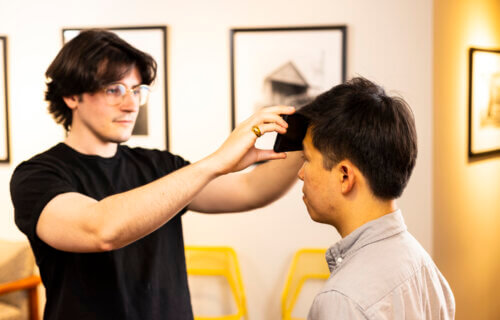SEATTLE — Feeling sick, but can’t find a thermometer lying around? There’s an app for that. A team of scientists from the University of Washington are creating an app called “FeverPhone” that lets you use your phone as one.
FeverPhone transforms smartphones into thermometers without any additional hardware. To make it work, the phone’s touchscreen is utilized and the existing battery temperature is repurposed to gather data that allows a machine-learning model to estimate body temperature. When the researchers tested the app on 37 patients in an emergency department, the app accurately measured temperature within acceptable clinical parameters.
“In undergrad, I was doing research in a lab where we wanted to show that you could use the temperature sensor in a smartphone to measure air temperature,” says lead author Joseph Breda, a UW doctoral student in the Paul G. Allen School of Computer Science & Engineering, in a media release. “When I came to the UW, my adviser and I wondered how we could apply a similar technique for health. We decided to measure fever in an accessible way. The primary concern with temperature isn’t that it’s a difficult signal to measure; it’s just that people don’t have thermometers.”
The app is the first to use existing phone sensors and screens to estimate fevers. More training data is needed before the technology can be widely applied. Just having this data alone is exciting for physicians, though.

“People come to the ER all the time saying, ‘I think I was running a fever.’ And that’s very different than saying ‘I was running a fever,’” says Dr. Mastafa Springston, a co-author on the study and a UW clinical instructor at the Department of Emergency Medicine in the UW School of Medicine. “In a wave of influenza, for instance, people running to the ER can take five days, or even a week sometimes. So if people were to share fever results with public health agencies through the app, similar to how we signed up for COVID exposure warnings, this earlier sign could help us intervene much sooner.”
How could a smartphone also serve as a thermometer?
Normally, clinical-grade thermometers use small sensors called thermistors to estimate body temperature. Smartphones also have thermistors, which are mainly used to monitor battery temperature. The researchers realized that these sensors might also be able to track heat transfer between a person and a phone as well.
To test things out, the team gathered data in a lab. They simulated a warm forehead using a heated plastic bag of water with a sous-vide machine, pressing phone screens against the bag. To account for changes in circumstances, like different people using different types of phones, the team tested three phone models and added common accessories like screen protectors. After running and calibrating their models in lab, they moved on to testing people.
The 37 participants pressed the touchscreen against their foreheads for close to 90 seconds. The average error was about 0.41 degrees F (0.23 degrees C), which is well within the clinically acceptable range of 0.5 C.
The team is already looking ahead to figuring out how to optimize the use of smartphones for this purpose, and also how to expand the technology to different smart devices, like watches.
“We started with smartphones since they’re ubiquitous and easy to get data from,” says Breda. “I am already working on seeing if we can get a similar signal with a smartwatch. What’s nice, because watches are much smaller, is their temperature will change more quickly. So you could imagine having a user put a Fitbit to their forehead and measure in 10 seconds whether they have a fever or not.”
The findings are published in the journal Proceedings of the ACM on Interactive Mobile Wearable and Ubiquitous Technologies.
